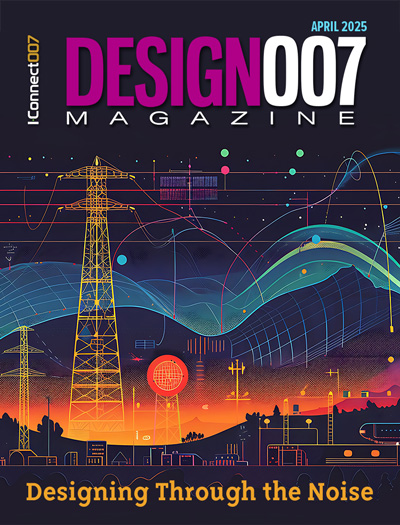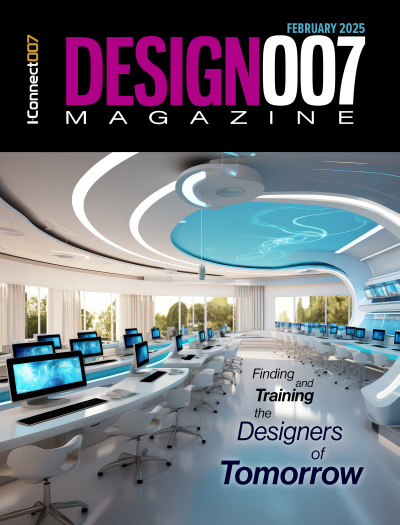-

- News
- Books
Featured Books
- design007 Magazine
Latest Issues
Current Issue
Designing Through the Noise
Our experts discuss the constantly evolving world of RF design, including the many tradeoffs, material considerations, and design tips and techniques that designers and design engineers need to know to succeed in this high-frequency realm.

Learning to Speak ‘Fab’
Our expert contributors clear up many of the miscommunication problems between PCB designers and their fab and assembly stakeholders. As you will see, a little extra planning early in the design cycle can go a long way toward maintaining open lines of communication with the fab and assembly folks.

Training New Designers
Where will we find the next generation of PCB designers and design engineers? Once we locate them, how will we train and educate them? What will PCB designers of the future need to master to deal with tomorrow’s technology?
- Articles
- Columns
Search Console
- Links
- Media kit
||| MENU - design007 Magazine
Autodesk Donates $4.3 Million to Cornell University to Prepare students for an AI-powered future
April 24, 2025 |Estimated reading time: 3 minutes
Autodesk announced a $4.3 million gift to Cornell University’s College of Engineering and College of Architecture, Art, and Planning (AAP) to help prepare students for the future of work in an increasingly AI-driven world. The investment will fund a new Autodesk Cornell Engineering Design and Make Space in Upson Hall.
This interdisciplinary facility will serve as a hub for experiential learning, where students can prototype, collaborate, and build using the same advanced tools and platforms as industry professionals—including free access to Autodesk Fusion, an all-in-one platform for CAD, CAM, and generative design.
“The world urgently needs skilled talent to design and make the brighter future we know is possible—but right now, there’s a critical skills gap,” said Dara Treseder, Chief Marketing Officer at Autodesk. “Autodesk is committed to closing this gap by putting cutting-edge technology directly into the hands of tomorrow’s innovators. Our collaboration with Cornell University accelerates this effort, equipping the next generation of engineers, architects, and designers with the tools, technology, and real-world experience they need to build successful careers and shape our collective future.”
Cornell’s J. Meejin Yoon, Gale and Ira Drukier Dean of Architecture, Art, and Planning; Lynden A. Archer, Joseph Silbert Dean of Engineering; and Krystyn Van Vliet, Vice President for Innovation and External Engagement Strategy, join Autodesk’s Jeff Kinder, Executive Vice President of Product Development and Manufacturing Solutions, and Ruth Ann Keene, Executive Vice President of Corporate Affairs and Chief Legal Officer, for the official signing of the memorandum of understanding facilitated by robotic arms in AAP’s Autodesk Design and Make Space. Anson Wigner / AAP
Closing the skills gap
The announcement coincides with the release of Autodesk’s 2025 State of Design & Make report, which found that AI is now the number one skill employers are hiring for across Design and Make industries. Meanwhile, 61% of industry professionals say new employees with the right technical skills are difficult to find, up 16 points from last year.
Autodesk’s long-standing collaboration with Cornell directly addresses this challenge and focuses on helping students across architecture, engineering, and more develop the right skillsets for jobs of the future.
As part of this gift, Cornell Engineering and AAP will each receive $2 million to enhance fabrication labs, research spaces, and prototyping tools, plus $150,000 in discretionary funds to accelerate innovation and instruction.
“The Autodesk Design and Make Space in Cornell Engineering is an investment in the future of experiential learning in our college that impacts students college-wide,” said Lynden Archer, Joseph Silbert Dean of Engineering. “I am grateful for and encouraged by Autodesk’s support of our efforts to educate problem solvers with combined hands-on and computational design expertise, which is critical in modern engineering and design practice.”
Equipping students to build a sustainable future
At the College of Architecture, Art, and Planning, Autodesk’s donation names the AAP Autodesk Design and Make Space, which encompasses the current fabrication shops in Rand Hall. It will also enhance other maker spaces in the college, support research into emerging technologies, and align with growing student demand for green jobs and sustainable design education.
And the need has never been clearer:
- 3 in 4 professionals at tech-advanced companies say sustainability efforts help attract and retain top talent.*
- Nearly half of college students say they want to pursue a career in sustainability — but need the skills and training to get there.**
“At AAP, teaching, research, and learning thrive in environments that scaffold creativity, innovation, and iteration and encourage fluidity between digital and analog techniques,” said J. Meejin Yoon, Gale and Ira Drukier Dean of AAP. “This generous contribution to our college enables us to see that our spaces for creation and fabrication remain at the forefront and enable opportunities for collaboration across fields. Helping to further AAP’s mission, Autodesk’s gift ensures our faculty are well-supported, and our students are prepared to drive transformation across our disciplines with the resources, tools, and technologies needed to both inspire and actualize imagination.”
Why it matters now
As industries evolve at the speed of technology, the workforce is struggling to keep up. According to Autodesk’s 2025 State of Design & Make report:
- 46% of employers say AI skills are a top hiring priority.
- 58% say a lack of skilled talent is a barrier to their company’s growth—up 15 points from last year.
Autodesk’s investment is designed to help close that gap—giving students the technology, training, and experience to thrive in a world shaped by AI, sustainability, and innovation.
Suggested Items
Ansys Strengthens Collaboration with TSMC on Advanced Node Processes Certification and 3D-IC Multiphysics Design Solutions
04/24/2025 | PRNewswireThrough continued collaboration with TSMC, Ansys announced enhanced AI-assisted workflows for radio frequency (RF) design migration and photonic integrated circuits (PICs), and new certifications for its semiconductor solutions. Together,
Driving Sustainability in PCB Design
04/24/2025 | Marcy LaRont, I-Connect007Filbert (Fil) Arzola is an electrical engineer at Raytheon. He’s smart, entertaining, and passionate about PCB design. As it turns out, he’s also passionate about “Mother Earth,” as he calls her. Born and raised in Southern California, he freely admits that he turns the water off when he brushes his teeth and yells at his brother for throwing batteries in the garbage. But when looking at the issue of sustainability and PCB design, he urges his audiences to ponder what sustainability looks like. Can PCB designers, he asks, make any impact on sustainability at all?
Real Time with... IPC APEX EXPO: Silicon Geometry's Signal Integrity Impact on PCBs
04/24/2025 | Marcy LaRont, I-Connect007At IPC APEX EXPO 2025, Kris Moyer addressed the importance of understanding the impact of silicon geometry reduction on signal integrity and PCB performance. Kris says signal integrity considerations are necessary for so many designs today, regardless of clock frequency. He discusses valuable insights from attendees regarding embedded resistor technology and the effects of radiation on smaller silicon features in aerospace applications.
Elementary Mr. Watson: Navigating RF—A Glide Path Approach to Design Success
04/24/2025 | John Watson -- Column: Elementary, Mr. WatsonOn a flight, I can always tell when we begin our descent because that subtle drop in my stomach tells me the altitude has changed. Landing an airplane involves a gradual, precise process called the glide path. It descends at the correct speed and 3-degree angle to touch down smoothly and safely on the runway without bouncing or coming to a sudden stop. Pilots use specialized tools like the Instrument Landing System (ILS) or GPS to stay on the correct path. Lights on the ground, called PAPI lights, help pilots know if they are too high or too low.
Explore Thermal Management Solutions in Latest Podcast Series—New Episode Now Available
04/23/2025 | I-Connect007I-Connect007 is excited to share the latest episode in our new podcast series! In this episode, Ryan returns to discuss practical strategies for managing heat, starting early in the design planning and specification phases. After all, prevention means there’s less to mitigate later.


